Blue Ridge Mountains
| Blue Ridge Mountains | |
|---|---|
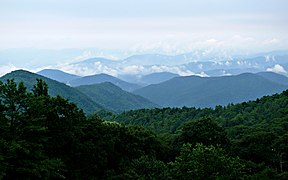 | |
| Highest point | |
| Peak | Mount Mitchell |
| Elevation | 6,684 ft (2,037 m) |
| Coordinates | 35°45′53″N82°15′55″W/ 35.76472°N 82.26528°W |
| Geography | |
| Country | United States |
| States | North Carolina,Virginia,Tennessee,Maryland,Pennsylvania,West Virginia,South Carolina,GeorgiaandAlabama |
| Parent range | Appalachian Mountains |
| Geology | |
| Orogeny | Grenville orogeny |
| Type of rock | granite, gneiss and limestone |
TheBlue Ridge Mountainsare aphysiographic provinceof the largerAppalachian Highlandsrange. The mountain range is located in theEastern United Statesand extends 550 miles southwest from southernPennsylvaniathroughMaryland,West Virginia,Virginia,North Carolina,South Carolina,Tennessee,andGeorgia.[1]The province consists of northern and southern physiographic regions, which divide near theRoanoke Rivergap.[2]To the west of the Blue Ridge, between it and the bulk of the Appalachians, lies theGreat Appalachian Valley,bordered on the west by theRidge and Valleyprovince of the Appalachian range.
The Blue Ridge Mountains are known for having a bluish color when seen from a distance. Trees put the "blue" in Blue Ridge, from theisoprenereleased into the atmosphere.[3]This contributes to the characteristic haze on the mountains and their perceived color.[4]
Within the Blue Ridge province are two major national parks: theShenandoah National Parkin the northern section and theGreat Smoky Mountains National Parkin the southern section. TheBlue Ridge Parkway,a 469-mile (755 km) long scenic highway, connects the two parks and runs along the ridge crest-lines, as does theAppalachian Trail.[5]Eight national forests includeGeorge Washington and Jefferson,Cherokee,Pisgah,NantahalaandChattahoochee.
Geography[edit]

Although the term "Blue Ridge" is sometimes applied exclusively to the eastern edge or front range of the Appalachian Mountains, the geological definition of the Blue Ridge province extends westward to theRidge and Valleyarea, encompassing theGreat Smoky Mountains,theGreat Balsams,theRoans,theBlacks,and other mountain ranges. To the east, two lower elevation ranges referred to asfoothillsare also often included as "spurs" of the Blue Ridge: theBrushy Mountainsand theSouth Mountains.
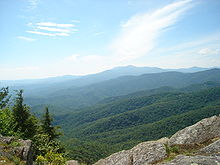
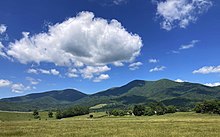
The Blue Ridge extends as far south asMount OglethorpeinGeorgiaand as far north intoPennsylvaniaasSouth Mountain.While South Mountain dwindles to hills betweenGettysburgandHarrisburg,the band of ancient rocks that form the core of the Blue Ridge continues northeast through theNew JerseyandHudson Riverhighlands, eventually reaching theBerkshiresofMassachusettsand theGreen MountainsofVermont.
The Blue Ridge contains the highest mountains in eastern North America south ofBaffin Island.About 125 peaks exceed 5,000 feet (1,500 m) in elevation.[6]The highest peak in the Blue Ridge (and in the entire Appalachian chain) isMount MitchellinNorth Carolinaat 6,684 feet (2,037 m). There are 39 peaks in North Carolina and Tennessee higher than 6,000 feet (1,800 m); by comparison, in the northern portion of the Appalachian chain onlyNew Hampshire'sMount Washingtonrises above 6,000 feet (1,800 m).Southern Sixersis a term used bypeak baggersfor this group of mountains.[7]
TheBlue Ridge Parkwayruns 469 miles (755 km) along crests of the southern Appalachians and links two national parks:ShenandoahandGreat Smoky Mountains.In many places along the parkway, there aremetamorphicrocks (gneiss) with folded bands of light-and dark-colored minerals, which sometimes look like the folds and swirls in a marble cake.
Geology[edit]
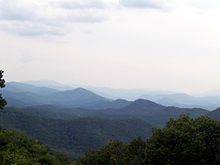
Most of the rocks that form the Blue Ridge Mountains are ancientgraniticcharnockites,metamorphosed volcanic formations, and sedimentary limestone. Recent studies completed by Richard Tollo, a professor and geologist atGeorge Washington University,provide greater insight into the petrologic and geochronologic history of the Blue Ridge basement suites. Modern studies have found that thebasement geologyof the Blue Ridge is made of compositionally unique gneisses andgranitoids,including orthopyroxene-bearing charnockites. Analysis ofzirconminerals in the granite completed by John Aleinikoff at theU.S. Geological Surveyhas provided more detailed emplacement ages.

Many of the features found in the Blue Ridge and documented by Tollo and others have confirmed that the rocks exhibit many similar features in other North AmericanGrenville-ageterranes.The lack of a calc-alkaline affinity and zircon ages less than 1.2 billion years old suggest that the Blue Ridge is distinct from theAdirondacks,Green Mountains, and possibly theNew York–New Jersey Highlands.Thepetrologicandgeochronologicdata suggest that the Blue Ridge basement is a composite orogenic crust that was emplaced during several episodes from a crustal magma source. Field relationships further illustrate that rocks emplaced prior to 1.078–1.064 billion years ago preserve deformational features. Those emplaced post-1.064 billion years ago generally have a massive texture and missed the main episode of Mesoproterozoic compression.[8]
At the time of their emergence, the Blue Ridge were among the highest mountains in the world and reached heights comparable to the much youngerAlps.Weathering,erosion,andmass wastingover hundreds of millions of years has resulted in much shorter peaks.[9]
History[edit]

At the foot of the Blue Ridge, various tribes including theSiouanManahoacs,theIroquois,and theShawneehunted and fished. A German physician-explorer,John Lederer,first reached the crest of the Blue Ridge in 1669 and again the following year; he also recorded theVirginia Siouanname for the Blue Ridge (Ahkonshuck).
At theTreaty of Albanynegotiated by Virginia Lieutenant GovernorAlexander Spotswoodwith the Iroquois between 1718 and 1722, the Iroquois ceded lands they had conquered south of thePotomac Riverand east of the Blue Ridge to theVirginia Colony.This treaty made the Blue Ridge the new demarcation point between the areas and tribes subject to the Six Nations, and those tributaries to the colony. When colonists began to disregard this by crossing the Blue Ridge and settling in theShenandoah Valleyin the 1730s, the Iroquois began to object, finally selling their rights to the valley, on the west side of the Blue Ridge, at theTreaty of Lancasterin 1744.
Flora and fauna[edit]
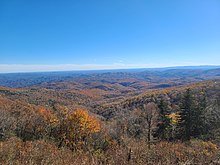
Flora[edit]
The Blue Ridge Mountains have stunted oak andoak-hickory foresthabitats,which comprise most of the Appalachian slope forests. Flora also includes grass, shrubs, hemlock and mixed-oak pine forests.[10]
While the Blue Ridge range includes the highest summits in the eastern United States, the climate is nevertheless too warm to support analpine zone,and thus the range lacks thetree linefound at lower elevations in the northern half of the Appalachian range. Statistical modelling predicts that the alpine tree line would exist at above 7,985 feet (2434 m) in the climate zone and latitude of the southern Appalachians.[11]The highest parts of the Blue Ridge are generally vegetated in denseSouthern Appalachian spruce-fir forests.[citation needed]
Fauna[edit]
The area is host to many animals, including:
- Many species ofamphibiansandreptiles
- Ocoee salamander
- A large diversity offishspecies, many of which areendemic
- American black bear
- Songbirdsand other bird species
- Bobcat
- Coyote
- Red fox
- Gray fox
- Grouse
- North American River Otter
- Whitetail deer
- Wild boar
- Wild turkey
Population centers[edit]
The largest city located in the Blue Ridge Mountains isRoanoke,located inSouthwest Virginia,while the largest Metropolitan Statistical Area is theGreenville metropolitan areainUpstate, South Carolina.[12]Other notable cities in the Blue Ridge Mountains includeCharlottesville,Frederick,Hagerstown,Chambersburg,Asheville,Johnson City,andLynchburg.
See also[edit]
- Appalachian balds
- Appalachian bogs
- Appalachian temperate rainforest
- Appalachian-Blue Ridge forests
- Cove (Appalachian Mountains)
- Blue Ridge National Heritage Area
- List of subranges of the Appalachian Mountains
- Tennessee Frontiers: Three Regions in Transitionby John R. Finger
- Take Me Home, Country RoadsbyJohn Denver
References[edit]
- ^"Blue Ridge".U.S. Geological Survey.Archivedfrom the original on December 24, 2019.RetrievedDecember 19,2018.
- ^"Physiographic divisions of the conterminous U. S."U.S. Geological Survey.Archivedfrom the original on December 5, 2007.RetrievedDecember 6,2007.
- ^Johnson, A. W. (1998).Invitation To Organic Chemistry.Jones & Bartlett Learning. p.261.ISBN978-0-7637-0432-2.
blue mountains chemical terpene.
- ^"Blue Ridge Parkway, Frequently Asked Questions".National Park Service. 2007.Archivedfrom the original on December 28, 2007.RetrievedDecember 29,2007.
- ^Leighty, Dr. Robert D. (2001)."Blue Ridge Physiographic Province".Contract Report.Defense Advanced Research Projects Agency (DOD) Information Sciences Office.Archivedfrom the original on May 21, 2008.RetrievedDecember 29,2007.
- ^Medina, M.A.; J.C. Reid; R.H. Carpenter (2004)."Physiography of North Carolina"(PDF).North Carolina Geological Survey, Division of Land Resources.Archived(PDF)from the original on December 16, 2007.RetrievedDecember 29,2007.
- ^"South Beyond 6000".Archived fromthe originalon March 3, 2016.RetrievedSeptember 19,2016.
- ^Tollo, Richard P.; Aleinkoff, John N.; Borduas, Elizabeth A. (2004)."Petrology and Geochronology of Grenville-Age Magmatism, Blue Ridge Province, Northern Virginia".Northeastern Section (39th Annual) and Southeastern Section (53rd Annual) Joint Meeting.Geological Society of America.Archivedfrom the original on October 22, 2007.RetrievedNovember 9,2006.
- ^Davis, Donald E.; Colten, Craig E.; Nelson, Megan Kate; Saikku, Mikko; Allen, Barbara L. (2006).Southern United States: An Environmental History.ABC-CLIO. p. 261.ISBN9781851097807.Archivedfrom the original on November 25, 2020.RetrievedApril 22,2019.
- ^"Blue Ridge Mountains".The New Georgia Encyclopedia.Archivedfrom the original on June 17, 2010.RetrievedSeptember 4,2016.
- ^Cogbill, Charles V.; White, Peter S.; Wiser, Susan K. (1997)."Predicting Treeline Elevation in the Southern Appalachians".Castanea.62(3): 137–146.JSTOR4033963.
- ^"2020 State-based Metropolitan and Micropolitan Statistical Areas Maps".
Further reading[edit]
- Olson, Ted (1998).Blue Ridge Folklife,University Press of Mississippi.ISBN1-57806-023-0.
External links[edit]
 Media related toBlue Ridge Mountainsat Wikimedia Commons
Media related toBlue Ridge Mountainsat Wikimedia Commons Blue Ridge Mountainstravel guide from Wikivoyage
Blue Ridge Mountainstravel guide from Wikivoyage
- Blue Ridge Mountains
- Subranges of the Appalachian Mountains
- Mountain ranges of North Carolina
- Mountain ranges of Virginia
- Mountain ranges of Georgia (U.S. state)
- Mountain ranges of Maryland
- Mountain ranges of Pennsylvania
- Mountain ranges of Tennessee
- Mountain ranges of South Carolina
- Mountain ranges of West Virginia
- Geography of Appalachia
- Regions of Tennessee
- Appalachia
- Appalachian culture
- Roanoke River
- Shenandoah River
- Rappahannock River
- Physiographic provinces
- Physiographic regions of the United States
- Volcanoes of Virginia
- Volcanoes of the United States

